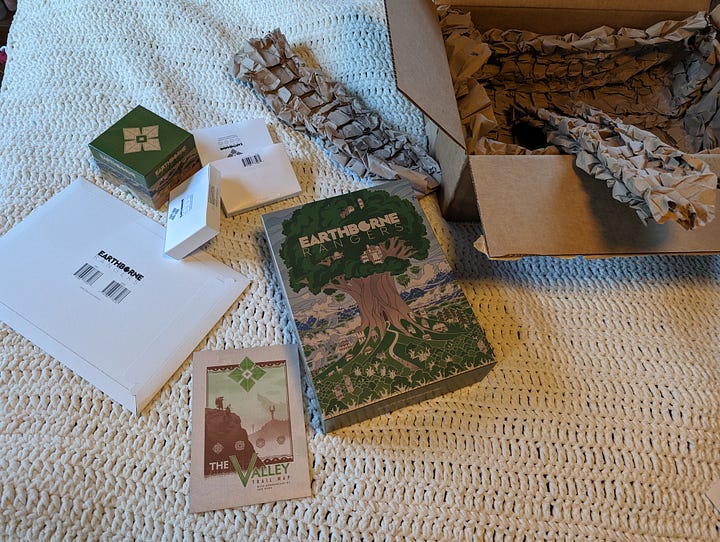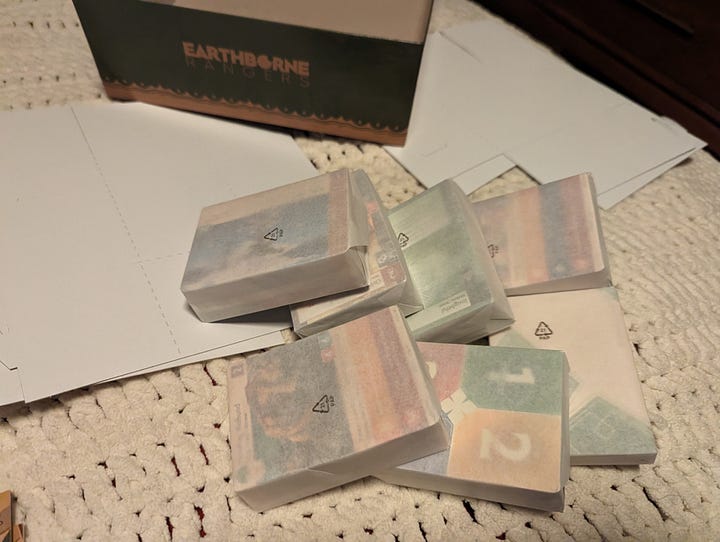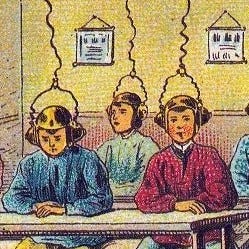Earthborne Rangers: a Game for the Future, the Future of Games
Extracurriculars
There’s a new favorite game in the Markwell house (though it’s rare we have 3-4 straight hours with all the right people at home); it’s a cooperative, semi-roleplaying strategy game called Earthborne Rangers, the passion project of Andrew Navaro, formerly of Fantasy Flight Games. This game is relevant to Futures in a few different ways, both inside and outside the magic circle of the game itself.
Distribution
Although the story of the last two decades of retail is largely the story of the Amazon-ification of everything1, the seeds of what’s coming next are already sprouting. Amazon has become a victim of its own success and the search experience has become a disaster2. Boardgames have had some specific issues on the platform, specifically with widespread counterfeiting. One solution to this problem is for people to return to cultivating relationships with trusted online brands for things where quality and/or responsibility matters but is hard to assess, such as cleaning supplies, toilet paper, or menswear. Earthborne Rangers is presently distributed in the US solely through Covenant Games, which curates a specific subset of the market and establishes long-term relationships with publishers and (often) customers.
In addition, the game was originally funded via Kickstarter, with a group of a few thousand backers (including me) paying money over two years ago to fund the development and production of the game, in exchange for the product once it’s finished. This is becoming a common funding model for games, from independent developers with a dream to big studios and brands, because it shifts the risk from the producer to the consumer, gives reliable data for determining the size of a production run, and allows the capture of more of the revenue over the producer-distributor-retailer model. In general, this is an example, along with GoFundMe and similar sites, of the long-term trend of the fundraising/micro-business side of Web 2.0.
Production
A major part of what’s interesting about Earthborne (both the game and the studio) is the commitment to sustainability. This required not just paying more for certain components and finding alternatives to single-use plastic, but more or less building a custom supply chain. The company engaged a team at the University of Illinois to figure out how to make the game completely sustainable and biodegradable. Their work covered: finding FSC-certified producers close to FSC forests, understanding the certification process, evaluating wood vs bioplastics, understanding the most sustainable way to make playing cards (paper, the adhesive that goes between the front and back of cards and makes them stiff, the type of ink used, and the protective coating), and getting reliable information about recyclability. The Illinois team also researched the producers, whittling a list of 77 companies down to 6 that seemed interested, able to produce in the desired way, and aligned with Earthborne’s mission.
This commitment extends not just to the game components but also to the packaging and shipping materials - no plastic involved in wrapping things up or even in the shipping materials - it came packed in brown paper which felt every bit as protective as the standard plastic air pillows Amazon uses. The commitment to live their ethos in the whole process of the game is commendable, and it seems to be catching on - similar commitments have been made by Matt Leacock’s Daybreak, for example.


Setting
But we haven’t even started talking about the game itself; fortunately, it’s super fun, and bakes its futures thinking directly into the game in multiple ways. The game is set 2,500 years in the far future, after two major turns of history: first, people invested in generations-long engineering projects to heal the planet from the effects of climate change, and hunkered down in arcologies; second, the arcologies eventually break down, and humans re-enter a lush but transformed world. This setting combines elements of Dator’s transformation and post-collapse archetypes, with an aesthetic the creators call “ponchopunk”: essentially solarpunk but with fewer machines and more hiking. Though the game doesn’t dwell on it, the assertion - that climate change and ecosystem collapse can be solved if enough people care enough to change the current systems - is deeply hopeful.
Mechanics and Objectives
That sense of optimism is carried into the way the game is played. Players take the role of Rangers, who wander around the Valley and serve as general problem-solvers for the residents of its interconnected small communities. Consistent with the post-capitalist ethos, the game is cooperative and open, and players work together to accomplish missions as they present themselves, or to explore somewhere else instead. There’s not much in terms of fighting zombies or stopping nefarious schemes; the missions so far have revolved around finding missing people, ridding villages of big predators, and searching the ruined arcologies to learn their secrets. In fact, there’s hardly any fighting at all; even with a wild animal, it’s often a better idea to steer clear of it or try to placate it than to resort to force. All of this helps showcase the elements of the designer’s preferred future: gentler, more locally-focused, without central direction, sustainable, and collaborative3.
One unique way the game evokes a non-anthropocentric view is via the natural world’s interaction around you. When the board gets full, in the course of a single player action, you might find the sun beating down on you, predators hunting, animals eating the plants in the underbrush or fighting one another over potential mates, etc. I’ve never seen this level of ambient interaction in a boardgame before, and it really suggests a thriving ecology that exists whether or not we’re around to witness it.
Final Thoughts
I’ve written a lot about how games can be used in futures work. I think this is a really fruitful way to get people directly interacting with potential future dynamics. However, in a general audience, there is a pretty low ceiling on the depth and complexity of the game before it stops being effective4. When you start with a group that’s already self-selected for strategy games, you can experiment with a much richer game experience, which enables Futures learning to come from emergent gameplay, and allows for more memorable moments that show the consequences of the systems in a given future rather than just tell them. Both in its production and gameplay, Earthborne Rangers communicates a strong future vision.
And board games have a similar long-tail, specific-title focus that approximates the books that formed the original core of Amazon’s success.
Because the ad business competes with the finding-and-buying-the-right-thing business, because of Amazon’s anti-competitive practices and changes to how the recommendations work, and because search optimization has become a game to be mastered with review management as a sub-game.
These are values, of course, that don’t require millennia and civilizational collapse to embrace; the game’s setting creates the distance to let this difference breathe a little bit.
All of us have either had the experience of: trying to teach a new game to someone, having that person reach their cognitive limit, and have them give up and suggest you play their turn for them; or we’ve been that person.



